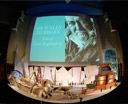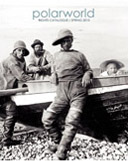 Our ProductsOur Resources |
This website requires the free Flash plugin to be installed.
Polarworld - discover more polar booksThe Arctic Book Review The Encyclopedia of the Arctic The Encyclopedia of the ArcticEdited by Mark Nuttall Reviewed by David Owen If you look under `encyclopedia' in the new three-volume Encylopedia of the Arctic you find Encyclopaedia Arctica and the story of the first attempt at an Arctic Encyclopedia. Seems that in 1946 Arctic explorer Vilhjalmur Stefansson, working out of Dartmouth College in New Hampshire, proposed the project to the American Navy who agreed to fund his four to six million word Arctic Omnibus. The Arctica rolled along amassing articles until 1949 when Stefansson requested further funding for the project and was told by the Office of Naval Research that the project was to be closed within the year. Why? Philip N. Cronenwett, author of the article on the subject in the Encyclopedia of the Arctic writes, “ The Office of Naval Research likely feared that the sponsorship of such an international project would raise suspicions within the anti-Soviet climate of the cold war era.” It seems Stefansson's research for the Soviet Arctic section looked too much like collaboration and so the first Arctic Encyclopedia fell victim to the Cold War. After the Navy withdrew its funding, Stefansson tried to get the work published commercially, but there were no takers, and for decades the manuscript languished. Finally in 1974, Dartmouth College made available a microfilm of the final typescript (some 20,000 pages in 17 volumes). Yet the story doesn't end there. It's currently becoming the Encylopedia Arctica Electronica as part of Dartmouth's College digital publishing program, a project, currently underway to convert the microfilm version into PDF files for an upcoming web site. Even if the Arctica finally navigates the turbulent funding waters to find a berth as a web site, it will still be the quaint older relative to the shiny new Encyclopedia of the Arctic edited by Mark Nutall and published by Routledge. Although the three-volume set, at a mere 2278 pages, is more modest than Stefansson's Arctica, the work is advertised as a truly multidisciplinary work that covers “environmental science, anthropology, ecology, geology, archaeology and history, linguistics, meteorology, politics, economics, and cultural studies of the Arctic.” I must admit that the first thing that struck me as I thumbed through my newly arrived volumes was the complete absence of colour photos or illustrations. The only colour is on the covers of the three books. Obviously the expense of publishing an encyclopedia hasn't changed since Steffansson's day. Yet the books are handsome and set in a type size that is easy on the eyes. I'm not sure how many million words they contain but they are sufficient to make a comprehensive review impossible. I can only hope to hike a few trails in the vast terrain these books represent. I have no official qualifications, simply an abiding passion for the literature of the Franklin search. The Arctic I know best is full of men in ships seeking the lost Franklin, a core sample of a far vaster history, a thin slice of place and time in the Canadian Arctic Archipelago. Therefore to test drive these hefty volumes my first step is to discover who of the classic British Arctic fraternity is represented. And it seems all the major players are here. Parry, The Franklins, The Rosses, Kane and Belcher, Kennedy and Bellot, Rae, Collinson, McClure, McClintock, Ebierbing and Tookalitoo (aka Eskimo Joe and Hannah) John Barrow and too many dozens more to list. To give you a sense of the encyclopedia's scope in the first volume the contents are listed by theme. In this listing Explorers and Exploration is found between Economics and Fish and takes up about a page and a quarter in a listing that totals thirteen pages. It's full of unexpected delights, like new gossip about old friends. I was amazed to learn that Joseph René Bellot declined an invitation to serve under Elisha Kent Kane on the second Grinnell expedition. (p. 227 Bellot entry Ian D Hodkinson). Or the story of how William Kennedy, Bellot's one time partner in a Franklin search expedition actually was set to lead another search sponsored by Lady Franklin from the Pacific side. This search only got as far as Valparaiso, California where it met its end in 1853 when Kennedy's crew abandoned him for the gold rush. William Kennedy Captain is of particular interest to me since he is a rare Canadian born Franklin searcher who has an interesting life before and after his role in the Franklin Search. To compare I looked up Kennedy in the only other encyclopedia I own, the 3 volume edition of The Canadian Encyclopedia published by Hurtig in 1985. The entry on Kennedy starts “He was the son of a fur-trading father and an Indian mother,” while the Encyclopedia of the Arctic's short bio tells us he was “the son of Chief Factor Alexander Kennedy of the Hudson's Bay Company and his Cree wife, known as Aggathas.” The latter's detailed focus lifts Kennedy out of the haze of history and fills in the biography. It's a good example of the Encyclopedia's currency. Even as I digest the new information in Kennedy's bio I turn to another player in the Franklin search and read “Edward Belcher was the son of Andrew Belcher of Halifax, Nova Scotia Canada, and grandson of the then governor of the Province William Belcher..." Could it be that , yes, the pompous chicken-ass who ran away from the prospect of a third winter against the advice of his many seasoned Arctic hands, was in fact, a Canadian? Well I suppose running away from winter always has been a Canadian pastime. Belcher was a just an early snowbird. The entry does add some context to the life and career of man who is most famous for abandoning 4 perfectly seaworthy ships in the Canadian Arctic, including one that was able to sail back even without a crew. Yet in the Ian Hodkinson (pp. 223-4) focuses primarily on Belcher's Arctic Expedition. This makes me think to go to look up the famous story of the HMS Resolute. There is no entry devoted to the ship, but I find: Resolute Bay was named after the HMS Resolute, a ship in the British H.T. Austin expedition of 1850-51, searching for the lost John Franklin. The ship was abandoned in the summer of 1854 and drifted into Davis Strait, where it was picked up by an American Whaler,the George Henry, in September 1855. (Vol.3 page 1761, Frank James Tester) One wonders how a ship that was searching for Franklin in 1850-51 was abandoned in the summer of 1854. While strictly speaking not wrong, this entry is confused. While it is true that Austin commanded the Resolute during the 1851 search, the man who reluctantly abandoned the Resolute on Belcher's orders was Captain Henry Kellet during the Belcher search 1852-1854. While there are full entries for Franklin, Lady Jane and Franklin, John (written by the Arctic Book Review's own Russell Potter), there is no overview entry called “The Franklin Search” where its involved history might be sorted. The best account of the Resolute is found in the Belcher entry where Belcher's failed search for Franklin is discussed at length. In fact this account of HMS Resoute is the definitive version in the encyclopedia. The Resolute was salvaged by the Americans and presented back to the British who subsequently decommissioned it. I've read many times of the oak desk made from its timbers that became John Kennedy's favorite but it was news that the ship's bell was presented to President Lyndon Johnson by Prime Minister Harold Wilson as late as 1965! Even 128 years after his death, Belcher's memory and the ship that sailed itself out of the Arctic are still entwined. That the Resolute story should be found in the body of the Belcher entry is an example of this encyclopedia's editorial style. The essays included are very much personal writings by interested parties, and they can vary widely in what they choose for inclusion. But these biographies are not available anywhere under one cover, only in journals or as a passing mention in other books. One such is William Penny the Scottish whaling captain who participated in the search for Franklin during his own whaling work and officially for one season. The essay tells me about Penny's expansive Arctic career in the whaling industry and Stefansson-like love of Arctic colonization schemes. Yet there is no entry for Horatio Austin, R.N., Penny's nemesis during the 1850 Franklin search expedition that Penny officially took part in. Another missing entry among the list of old British Arctic hands is one on Lieutenant Bedford PIM whose heroic journey to rescue the trapped and starving men of McClure's Investigator has earned him a special place in my history of the Victorian Arctic. One can understand that Pim is under the radar, being a lieutenant, but how about the commander of the ship he set out from to rescue those Investigators? Between Kayak and Kenai Peninsula there is no Henry Kellett, Captain of the Resolute during the 1852-54 Belcher search. None of the captains in that expedition, Sherard Osborn( Pioneer) and Pullen( North Star) are mentioned here except for Captain Leopold McClintock of HMS Intrepid whose fame for discovering Franklin's fate insured his inclusion. How each essayist deals with the scandalous aspects of their subject's lives is as salacious as the activity of encyclopedia reading is likely to get. The author of the essay on Belcher spares his subject not at all. In contrast to the entry on the aforementioned Stefansson. Stefansson is at the centre of a historical debate about the Canadian Arctic Expedition (1913-18) regarding his responsibility in the deaths incurred in an expedition he nominally led. Russell Potter, writing in an earlier issue of the Arctic Book Review, summed it up nicely when he wrote of “Vilhjalmur Stefansson, who managed to make a career of the kind of remote-control expeditions in which others got lost and stranded while he went on lecture tours.” Yet in the entry on Stefansson in the Encyclopedia, written by Gilsi Palsson, the whole issue is made mention of in a single line squeezed in between other subjects “Accounts of the Expedition are colored by an accident in which eleven of Stefansson's men lost their lives when their ship, the Karluk, became locked in the ice, broke and sank in November 1913." This lets him off scot-free. By not even raising the issue Palsson forbids even the spectre of censure. For the few who would use it as a Lives of Eminent Arctic Victorians, there are many entries still to be wished for. But this is just the measure of a narrow obsession and hardly an indicator of the value of this wide-ranging work of Arctic scholarship. The book is an invaluable repository. Although not the British Victorian Arctic Expedition book, yet even so it is the best collection of work on the subject and the source of much delight in the Tales of Arctic Knights. |
|
||
follow us  | join us | join us  | home | contact | home | contact
|
||||
|
© Copyright Polarworld Ltd
SiteWizard.co.uk Web Site Design Company |
||||


